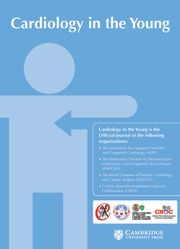No CrossRef data available.
Article contents
Radiculomegaly as a key clinical feature in oculo-facio-cardio-dental (OFCD) syndrome: a case report with a novel truncating variant in BCOR gene
Published online by Cambridge University Press: 11 October 2024
Abstract
Radiculomegaly is a rare dental anomaly characterised by the enlargement of the root canals of teeth. It is usually associated with oculo-facio-cardio-dental (OFCD) syndrome due to truncating variants in BCL-6 transcriptional corepressor (BCOR) (MIM*300485). We present the case of a 21-year-old female patient who was referred to genetics for a polymalformative syndrome including bilateral glaucoma and dental anomalies, especially radiculomegaly. Some others dysmorphic features were right superior lip notch, ogival palate, long philtrum, difficulty in pronation, café-au-lait spots, II-III toe bilateral syndactyly, and macrocephaly. Cone-beam CT confirmed radiculomegaly. The genetic analysis identified a heterozygous pathogenic variant NM_001123385.1:c.2093del (p.Pro698Glnfs*17) in the BCOR gene. After genetic diagnosis of OFCD syndrome, cardiac CT-scan revealed a large asymptomatic atrial septal defect that was subsequently surgically closed. Reviews of the literature have previously highlighted the prevalence of radiculomegaly in OFCD syndrome with a positive predictive value of 88.23% and a sensitivity of 75.94%. This case report highlights the importance of radiculomegaly as a clinical sign of OFCD syndrome, emphasising the rarity of non-syndromic radiculomegaly and the benefits of its diagnosis in clinical management, especially in cardiac screening.
- Type
- Original Article
- Information
- Copyright
- © The Author(s), 2024. Published by Cambridge University Press
Footnotes
Presented as a poster at EuroDysmorpho 2023 – 33rd European Meeting on Dysmorphology, ERN ITHACA



